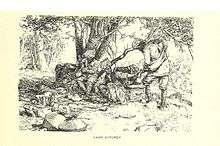Jammu dress

The people of Jammu have the following traditional costumes:
Ghagra Choli
It is traditional for women to wear the ghagra choli and scarf ensemble which was also popular in the Punjab.[1] It is still traditional for women to wear the kurta with a lehnga,[2] as an alternative to the suthan and kurta.
Peshwaj
The traditional ghagra choli was then replaced by the peshwaj for women which flows to the ankles which would sometimes be worn with a suthan (very loose pants with many folds).[3] The men would wear the Jamma (Mughal style shirt) with the suthan.
Suthan and kurta

The traditional dress for men and women is to wear the suthan and kurta but the styles are gender specific.
Dogri suthan
The traditional Dogri suthan is wide at the top, roomy at the legs and has numerous pleats at the ankles.[4]
Modern suthan

However, the modern style of suthan worn in Jammu is a remnant of the tight suthan which was once popular throughout the Punjab region. It is very loose at the top but is very tight from the knees to the ankles.[6][7][8] However, the style is now more popular in Jammu[9] and Himachal Pradesh[10] as the tight suthan is useful in the hills.[11] When worn by men, the drawers are called ghuttana and when worn by women, the suthan (in a variety of colours).[12] When the tight part of the suthan, up to the knees, has multiple close fitting folds, the suthan is referred to as Dogri pants[13] or Dogri suthan,[14] in Jammu and churidar suthan in Himachal Pradesh. It is also worn in the hilly area of the Punjab region.[15]In Jammu, members of all communities wear the suthan.[16]
The traditional Dogri kurta for men is open at the front and flares out from the waist to the knees. The kurta for women tends to be long and cut straight, a style adopted from neighbouring Punjab,[1] as local culture shares an affinity with the Punjab region,[17] especially the southern area.[18]
Churidar pajama
The churidar pajamma, also called churidar suthan, which forms part of the traditional attire of men and women in Punjab[19]is a combination of the tight suthan of the Punjab region and the traditional Dogri loose suthan. Accordingly, the churidar pajamma is believed to be derived from the suthan. The Churidar[1]pajama is popular all over the sub-continent and was developed in the Punjab region, and is associated with the Punjab.[20][21]
References
- 1 2 3 Kumar, Raj. Paintings and Lifestyles of Jammu Region: From 17th to 19th Century A.D
- ↑ Kumar Suresh Singh, K. N. Pandita, Sukh Dev Singh Charak, Baqr Raza Rizvi, Anthropological Survey of India Anthropological Survey of India(2003)
- ↑ Handa, O. Textiles, Costumes and Ornaments of the Western Himalyas
- ↑ Kumar, Raj (2006) page 163 Paintings and Lifestyles of Jammu Region: From 17th to 19th Century A.D.
- ↑ Gore, Frederick St. John. (1895) Lights & Shades of Hill Life in the Afghan and Hindu Highlands of the Punjab. A contrast ... With maps and illustrations, etc
- ↑ Letters from India and Kashmir (1874)
- ↑ Kumar Suresh Singh, K. N. Pandita, Sukh Dev Singh Charak, Baqr Raza Rizvi. Anthropological Survey of India (2003) Jammu and Kashmir
- ↑ Sukh Dev Singh Charak (1983) Jammu Kingdom, Part 1
- ↑ Bamzai, P. N. K. (1994) Culture and Political History of Kashmir, Volume
- ↑ Kumar Suresh Singh, B. R. Sharma, Anthropological Survey of India, A. R. Sankhyan (1996) Himachal Pradesh
- ↑ Charak, Sukh Dev Singh (1983) Himachal Pradesh, Volume 4
- ↑ Saraf, D.N. (1987) Arts and Crafts, Jammu and Kashmir: Land, People, Culture
- ↑ Banerjee, Sanhati. The Rockstar Dhoti (15.01.2012)
- ↑ Kumar, Ritu (2006) Costumes and textiles of royal India
- ↑ GORE, Frederick St. John. (1895) Lights & Shades of Hill Life in the Afghan and Hindu Highlands of the Punjab. A contrast ... With maps and illustrations, etc
- ↑ Sarfi, Maqsooda (2004 Japan From The Eyes Of An Indian Girl
- ↑ Betts, Vanessa and McCulloch, Victoria (2014) Indian Himalaya Footprint Handbook: Includes Corbett National Park, Darjeeling, Leh, Sikkim
- ↑ Biswas, Arabinda 1985) Indian Costumes [a dress of the Dogras in Jammu is greatly influenced by the sartorial ensemble of the State of Punjab.
- ↑ Kehal, Harkesh Singh. Alop ho riha Punjabi Virsa. Unistar Books PVT Ltd ISBN 978-93-5017-532-3
- ↑ The Grace of Four Moons: Dress, Adornment, and the Art of the Body in Modern India (2013)
- ↑ Kumar, Raj. Paintings and Lifestyles of Jammu Region: From 17th to 19th Century A.D